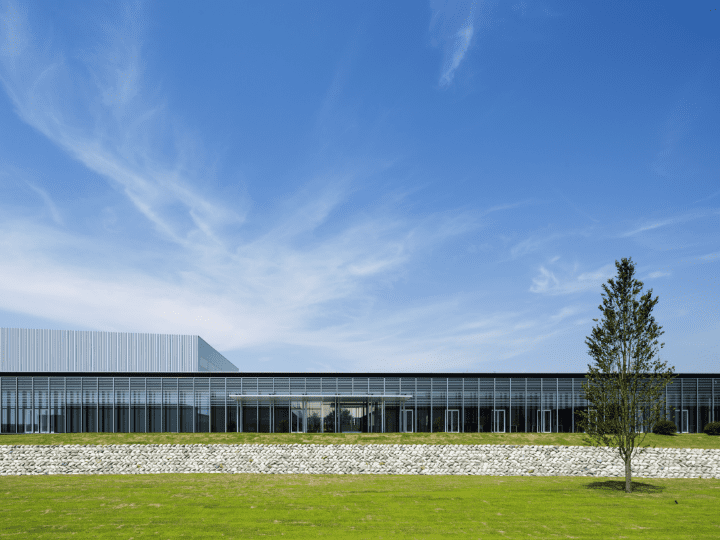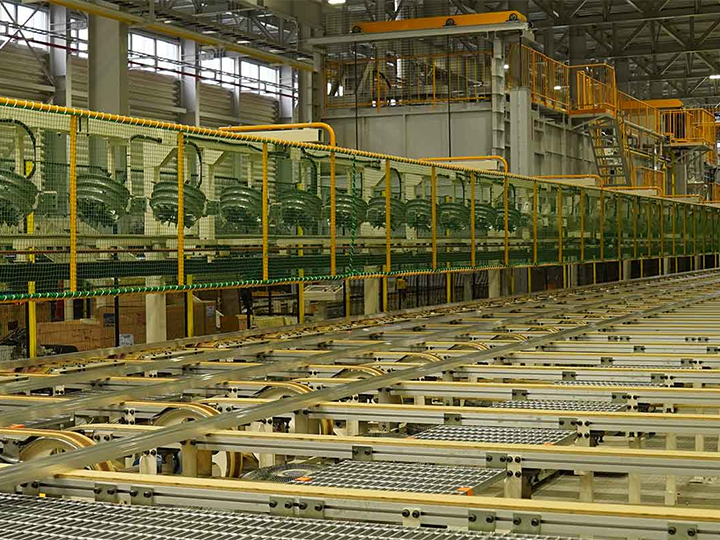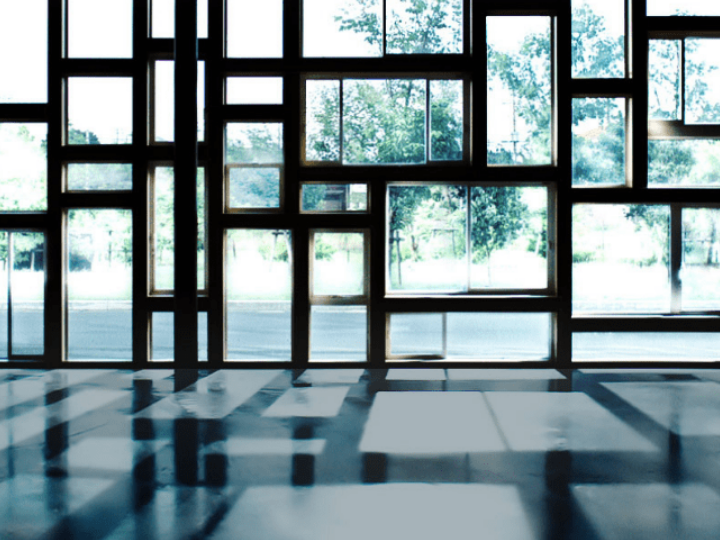
Verifying the use of classroom windows during the COVID-19 pandemic. The path to devising “tasuki opening” (“opening inner and outer windows on opposite sides”), which ventilates without losing the effectiveness of air conditioning.
Initiatives to improve the school environment by installing inner windows
YKK AP has proposed installing "inner windows," secondary windows that are attached on the inside of existing windows, to improve the learning environment in school facilities.
We started this proposal to create an environment in which children can study in a comfortable classroom that is warm in winter and not too hot in summer, and to realize energy efficiency by increasing the effectiveness of air conditioning, but it was a very hard fight to convey the effectiveness of inner windows. On top of this, the COVID-19 pandemic hit us just when we were able to make this effectiveness visible and create a proposal that was easy to understand. Having ventilation with open classroom windows became essential as an anti-infection measure, but this led to new challenges...
Table of Contents
- A hard-fought initial proposal that didn't convey the merits of inner windows
- The effectiveness of inner windows understood through on-site verification that made the most of the in-house verification division's knowledge
- New issues caused by the COVID-19 pandemic
- Devising “tasuki opening,” a ventilation method with optimal window opening that maintains a classroom's comfort
- A wish to contribute to solving social issues as a window manufacturer
We asked Shinya Yoshida, head of the Kanto Shin-Etsu Area, Development & Sales Department, Commercial Business Division and representative of all the members who worked on this, about the road to devising the "tasuki opening" ventilation method for a trade-off between "thermal insulation, thermal barrier and sound insulation = closed windows" and "ventilation = open windows," with cooperation from the Sales Division and the Development Division.
A hard-fought initial proposal that didn't convey the merits of inner windows
We first proposed installing inner windows in school facilities in 2019.
At this time, the Ministry of Education, Culture, Sports, Science and Technology (MEXT) was encouraging the installation of air conditioning in school facilities. We thought that inner windows would be optimal to increase the effectiveness of air conditioning and to realize higher energy efficiency, and started proposing this to elementary and junior high schools in the neighborhood. One aspect that made this product appealing is that local architectural product distributers can easily install it and so it contributes to regional business. However, it was a hard fight as we really didn't convey the merits of the product. This was because even we weren't certain that installing inner windows in classrooms would really be effective in terms of thermal insulation and sound insulation, even though we were the ones proposing the product. In principle, school classrooms have rows of windows on the outer wall side, while the corridor side is a simple partition wall with no capacity for thermal insulation or airtightness. Ultimately, how effective would it actually be to add inner windows only to the outer wall enclosing the classroom? This made it hard to persuade people.
In addition, the priority in the educational facilities field was quake-resistance retrofitting work, so there were few cases of thermal insulation improvement or installing inner windows in Japan, and it wasn't really accepted.

(Right) The "tasuki opening" devised by YKK AP

The effectiveness of inner windows understood through on-site verification that made the most of the in-house verification division's knowledge
We had verified the effectiveness of installing inner windows in homes on many occasions, but we needed to verify whether their effectiveness was properly apparent in school classrooms and then convey that effectiveness if they were to be used as inner windows in school facilities.
As we were wracking our brains, we received a proposal from Ryuji Mochiduki, who worked with us on proposal activities and was responsible for development: why didn't we try collaborating with the Value Verification Center,* which acts as our in-house product verification division, to verify the product's effectiveness by installing inner windows in actual school facilities? We decided to put this into practice.
Elementary and junior high schools in Nagano Prefecture and Gunma Prefecture cooperated with us for the verification. We made the most of the Value Verification Center's knowledge and measured the effectiveness of the product's thermal insulation in classrooms with the inner windows installed and in classrooms with the existing aluminum sash windows (no inner windows) twice, in summer and in winter. Measuring on hotter days in the summer and colder days in the winter made the effectiveness of the inner windows evident. It was difficult to manage the schedule so we could gain effective measurements when school events were also taking place.
*The YKK AP Value Verification Center: A facility that carries out different types of verification of product values (performance, security, ease of use, comfort) on sites belonging to people who actually use the products. It supports YKK AP's Monozukuri by identifying hidden issues through verification that replicates everyday living environments and severe natural environments, the opinions of user monitors, and an understanding of user demands from survey data.
Effectiveness of thermal insulation and thermal barrier
From the results of the verification, we were able to confirm that the inner windows were more effective than expected, with a 38% decrease in air conditioning electricity bills in the summer and a 27% decrease in the amount of kerosene used in heaters in the winter in the classrooms with the inner windows when compared to the classrooms with the existing aluminum sash windows.
Effectiveness of sound insulation
The verification of the effectiveness of the sound insulation was the same. We learned that the aluminum sash windows only curbed 65 dB sounds (a level that is felt to be loud) to 50 dB, but when the inner windows were installed, this dropped to 30 dB (the level of a small whisper).

(Left) Four thermometers in a classroom with inner windows installed. Thermometers were also similarly placed in classrooms with existing aluminum sash windows. This verified the temperature difference.
(Right) Children's voices recorded in advance in an outdoor pool sounded from the building opposite the classrooms, and we verified the effectiveness of the sound insulation.
New issues caused by the COVID-19 pandemic
Just when we understood the new value of the inner windows in school facilities, the COVID-19 pandemic hit. When we went to look at the classrooms with the inner windows installed, we saw lessons taking place with all the classroom windows open as an anti-infection measure. Ventilation was prioritized over thermal insulation and sound insulation. It was a real shame that the inner windows we had finally installed weren't properly demonstrating their effectiveness.
Under these circumstances, we wondered whether there was any way to ventilate the room while making the most of the inner windows' thermal insulation and sound insulation, and held an emergency meeting with the project members. We thought about future classroom windows and ventilation in the COVID-19 pandemic, and started verifying methods that would enable effective ventilation with the windows open without losing the effectiveness of heating and cooling via the air conditioning.

Yoshida with engineers from the Value Verification Center, Research & Development
(Left) From the left: Kouhei Morita, Ko Akimitsu, Yoshida, Takahiro Nishitani
(Right) Participating online: Ryuji Mochiduki, Kanto Shin-Etsu Product Development Office, Product Development, Residential Business Department, Research & Development Division
Devising “tasuki opening,” a ventilation method with optimal window opening that maintains a classroom's comfort
So Nishitani and Akimitsu, engineers from the Value Verification Center, devised a way of opening the windows that we called "tasuki opening." This proposal wondered whether opening the outer window and inner window on opposite sides would let the outside air in while increasing the effectiveness of the thermal insulation and sound insulation.

"Tasuki opening," devised by YKK AP
After this, we measured actual ventilation volume through a fluid simulation. When we used "tasuki opening," we found that the effectiveness of the sound insulation was the same level as when the conventional aluminum sash windows were closed, and we were able to secure 2.5 times the necessary ventilation volume. When it came to effectiveness in reducing energy costs, there was a 23% reduction in summer and a 35% reduction in winter when compared to ventilation achieved by opening the aluminum sash windows. We were able to confirm that the product can maintain thermal insulation and sound insulation effectiveness with the windows open, and so enable ventilation, and learned that "tasuki opening" is an optimal classroom ventilation method for the COVID-19 pandemic, as it enables constant ventilation while being less vulnerable to the outside environment in terms of heat or sounds.
When we asked the schools to experience this new way of using the inner windows during the COVID-19 pandemic, the principals and vice principals voiced satisfied opinions, and are making use of the method.

Ventilation volume, reduction rate of energy costs, and sound insulation when "tasuki opening" is used
A wish to contribute to solving social issues as a window manufacturer
Currently, we are going ahead with a proposal to install inner windows in other school facilities based on this series of verification outcomes. We are working with not only the Sales Division, but also with the people responsible for development and the engineers to create a proposal that will interest these customers. We have achieved this outcome together by sharing the issues considered by the people on the front lines of sales with the people in charge of development and engineering, with the joint desire of improving children's learning environments.
As we solve social issues as a window manufacturer, there is always something we can do to contribute to users. We want to make the most of the knowledge we gained from verifying this product so that inner windows will be adopted by schools across the country. In addition, we hope to continue verifying products other than inner windows as they are used so we can realize a better environment in school facilities in the future, and further this for proposals for school facilities such as gymnasiums that act as evacuation shelters during disasters. Another aim for the future is to share the value of our windows in a variety of areas, not just school facilities.

Shinya Yoshida
He joined the company in 1996, and worked for 20 years in YKK AP Hokkaido Commercial Architectural Products (name at the time). After serving as head of the Tomakomai Sales Office and the Hakodate Branch Office, he became head of the Kanto Shin-Etsu Area, Development & Sales, Commercial Business, his current position, in 2018. He carries out proposal and sales activities focused on building owners and architects for the future acquisition of prospective properties for the Kanto Shin-Etsu Division.
Share this article
- SNS Link X X Share
- SNS Link Facebook Facebook Share
- SNS Link LinkedIn LinkedIn Share
- SNS Link LINE LINE Share
- Copy Link Copy Link Copy Link Copied Link
Related stories
-

The Evolution of the Aluminum Profile Department into the Automotive Industry’s Manufacturer of Choice
- Aluminum Profile
- Technology
- Sustainability
- Solving Social Issues
-

Stop the Landfill Disposal of Used Vinyl Windows! Disseminating Vision for Vinyl Window Recycling Through Industry-Government-Academia Collaboration, and Taking on the Challenge of "Window-to-Window" Recycling
- Technology
- Manufacturing
- Environment
- Solving Social Issues
-

The installation training network began as a challenge to solve the shortage of sash and curtain wall installation technicians. Taking on challenges in collaboration with partners, and going from Japan to overseas
- Technology
- Installation
- Solving Social Issues
- Story of Project








